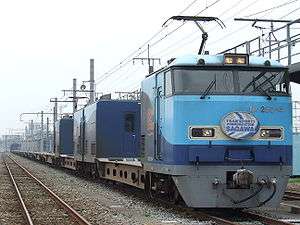M250 series
The M250 series (M250系, M250-kei), branded "Super Rail Cargo", is a freight electric multiple unit (EMU) train type operated by Japan Freight Railway (JR Freight) in Japan. It entered service in 2004 with the objective of reducing emissions and carrying general freight for small package forwarders (such as special delivery services). The M250 series is JR Freight's first container train with distributed traction. It is manufactured by Nippon Sharyo, Kawasaki Heavy Industries, and Toshiba.
| M250 series | |
|---|---|
 An M250 series train in June 2007 | |
| In service | 2004–present |
| Manufacturer | Kawasaki Heavy Industries, Nippon Sharyo, Toshiba |
| Constructed | 2002–2003 |
| Number built | 42 cars (2 full sets + spare cars) |
| Formation | 16 cars per trainset |
| Operator(s) | JR Freight |
| Depot(s) | Ōi |
| Line(s) served | Tōkaidō Main Line |
| Specifications | |
| Car length | 20,300 mm (66 ft 7 in) |
| Width | 2,800 mm (9 ft 2 in) |
| Maximum speed | 130 km/h (81 mph) |
| Traction system | Variable frequency (3-level IGBT) |
| Power output | 220 kW x 16 = 3,520 kW (4,720 hp) |
| Deceleration | 5.2 km/h/s |
| Electric system(s) | 1,500 V DC overhead |
| Safety system(s) | ATS-SF, ATS-PF |
| Track gauge | 1,067 mm (3 ft 6 in) |
Overview
Sagawa Express began operating one train as a reserved "Special high speed freight train" between Tokyo Freight Terminal and Ajikawaguchi Station (Osaka) on 13 March 2004, schedule revision. (The containers are owned by Sagawa Galaxy Highways.) Running with increasing frequency, it later became a regularly scheduled train (but with service suspended on Sundays and holidays).
The main formation is branded "Super Rail Cargo". It won the 2004 Minister of Land, Infrastructure and Transportation Eco-Products award for Eco-Service and the 2005 Japan Railfan Club Blue Ribbon Award (making it the first non-passenger vehicle to win since the JNR Class EF66 in 1969).
See also
- CargoSprinter, a German freight diesel multiple unit
References
- JR全車輌ハンドブック2009 [JR Rolling Stock Handbook 2009]. Japan: Neko Publishing. 2009. ISBN 978-4-7770-0836-0.
External links
| Wikimedia Commons has media related to JR Freight M250 series. |
- JR貨物M250系直流貨物電車スーパーレールカーゴ 概要, khi.co.jp (in Japanese), archived from the original on 24 August 2010, Profile on Kawasaki Heavy Industries website